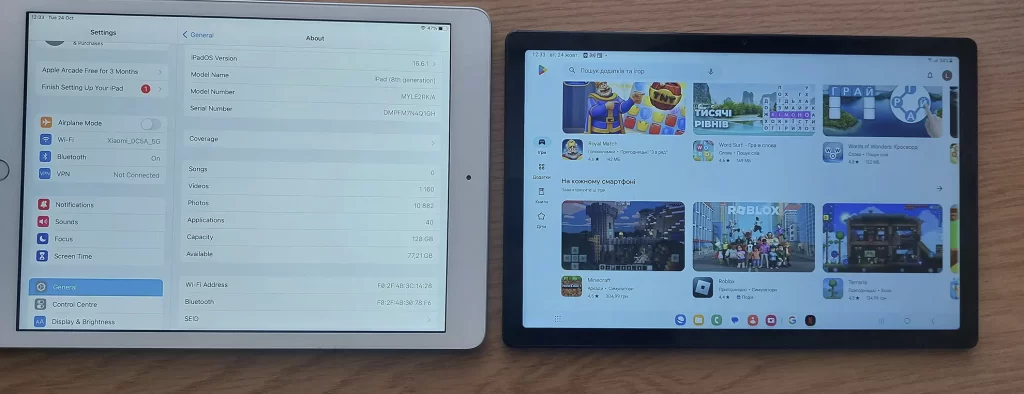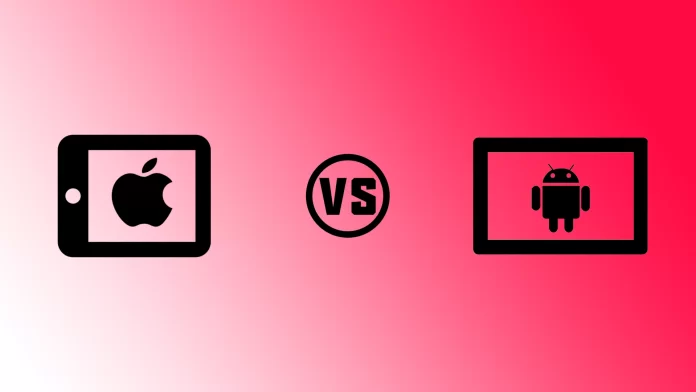A decade ago, tablets were hotly debated. Over time, however, smartphones have largely supplanted them. Today, tablets account for only 5% of the market. Positioned as an intermediate device between laptops and smartphones, tablets have found their niche in several key areas:
- Tablets for work
- Tablets for watching videos
- Tablets for studying
These are the most common uses for tablets today.
Two major operating systems dominate the tablet market: Android and iOS (iPad). Choosing between these two platforms has become an easy task for consumers given their distinctive features and user experience.
iPad (iOS) vs. Samsung Tablet (Android)

Right from the start, it’s clear that the iPad surpasses any Android tablet in overall performance. The iPad excels in home, school, and work environments, although Android tablets are often chosen for workplace settings due to their lower cost and the preference of many companies for Google’s ecosystem.
From personal experience with both the iPad and Samsung’s Galaxy Tab, I can confidently say that the iPad outshines its Android counterpart in every aspect, including convenience, battery life, and reliability.
One issue I encountered with the Galaxy Tab was a deep sleep glitch. If the tablet wasn’t used for more than two weeks, it wouldn’t turn on, appearing to be completely discharged. When connected to the charger, it initially showed a full discharge before displaying the actual battery level (e.g., 72%) after a few minutes, allowing it to power on. While I’m unsure if this glitch is specific to my device or a common issue, it certainly is inconvenient.
Tablet Comparison: iPad vs. Android vs. Amazon Fire
In today’s market, only two operating systems dominate the tablet landscape: Apple’s iOS and Android. However, some companies have customized Android to such an extent that their versions can be considered separate branches. A notable example is Amazon’s Fire tablets. While they are built on Android, they are specifically adapted for media consumption and are deeply integrated into Amazon’s ecosystem, including services like Alexa.
| Criterion | iPad | Android Tablet | Amazon Fire |
|---|---|---|---|
| Overall Rating | High performance, reliability, excellent software, and ecosystem | Varies in performance and reliability depending on the manufacturer | Affordable, basic performance, good for media consumption |
| Home Use | Excellent for multimedia, gaming, and reading | Good choice, many apps available, but may be less optimized | Good for media consumption, e-books, and basic tasks |
| School Use | Strong educational ecosystem, Apple Pencil support | Good for Google Classroom, affordable options | Limited educational apps, suitable for basic school tasks |
| Work Environment | Powerful processors, smooth performance, integration with Apple products | Integration with Google services, wide selection, flexibility | Not ideal for heavy work tasks, good for basic productivity |
| Price | More expensive, but justifies cost with quality and performance | More affordable models, wide price range | Very affordable, great value for basic use |
| Battery Life | Long battery life, excellent power management | Varies, depends on the model and manufacturer | Decent battery life, sufficient for everyday use |
| Glitches and Stability | Minimal glitches, stable performance | Variable stability, potential software issues | Generally stable, some performance limitations |
| Deep Sleep Issues | Not observed | Possible issues (e.g., Galaxy Tab not turning on after long inactivity) | Not commonly reported, generally reliable |
| App Ecosystem | Many high-quality apps optimized for iPad | Many apps available, not all optimized for tablets | Limited to Amazon Appstore, fewer apps than iPad and Android |
| Integration with Other Devices | Excellent integration with Apple products (MacBook, iPhone) | Good integration with Google services, open file system | Integrates well with Amazon services (Alexa, Kindle) |
| Customization | Limited customization options | Extensive customization capabilities, third-party app installation | Limited customization, locked to Amazon’s ecosystem |
| Software Updates | Long-term support, updates for older models | Depends on the manufacturer, not always regular updates | Regular updates, but fewer features compared to iOS and Android |
Personal opinion
- Having used both the iPad and Samsung Galaxy Tab, I’m convinced that the iPad is superior to Android tablets in every aspect: convenience, battery life, and reliability. In addition, Fire tablets, which are Android-based but integrated into Amazon’s ecosystem, combine the best features of both Android and Apple. They occupy a unique niche, offering a balance between the flexibility of Android and the quality of Apple’s OS, but with an emphasis on entertainment.




